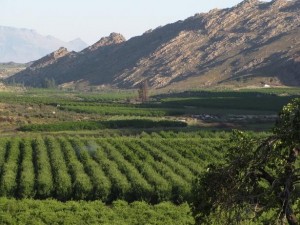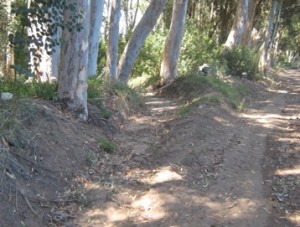In this post, Dr. James Dabrowski gives an introduction to the South African Council for Scientific and Industrial Research (CSIR) and their ongoing collaboration with scientists from Landau.

Typical agricultural orchard area in the Western Cape of South Africa (photo by J. Dabrowski)
The CSIR is one of the leading scientific and technology research, development and implementation organisations in Africa. The Natural Resources and Environment division of the CSIR undertakes world-class, directed, inter-disciplinary research and technological innovation, with partners and stakeholders, in the field of natural resources and the environment, to contribute to the social, economic and environmental improvement of South Africa and Africa.
To this end I have been collaborating with Prof. Ralf Schulz and other colleagues from the University of Koblenz-Landau over the past 10 years, focussing mainly on improving our knowledge of exposure and effects with respect to assessing the risk of pesticides to the aquatic ecosystem. This collaboration has its roots established from as early as 1999, when Prof. Schulz supervised me for my Masters and PhD studies in South Africa. This collaboration has been maintained over the years, surviving shifts in employment, resulting in numerous papers in scientific journals, exciting research and travel opportunities and plenty of fun along the way.

Erosion running to the left of a road adjacent to an orchard area (photo by J. Dabrowski)
Research conducted under this collaboration has always focussed specifically on testing hypotheses that are field relevant. For example buffer strips are often incorporated into modelling approaches in exposure assessments and are generally perceived to mitigate pesticide input via runoff – leading to lower environmental pesticide concentrations in adjacent water bodies. Collaborative research between the CSIR and University of Koblenz-Landau conducted in the Lourens River catchment, Western Cape, South Africa, has however shown that the physical integrity of buffer strips plays a significant role in their ability to mitigate pesticide transport. Dense vegetative buffer strips are often intercepted by so called ‘erosion rills’ which are preferential flow paths that cut through buffer strips. These erosion rills are effectively conduits that allow runoff associated pesticides to bypass the buffer strips and flow directly into an adjacent water body. If these erosion rills are not considered in exposure assessment modelling, predicted environmental concentrations can be significantly under-estimated. This has significant implications for regulatory decisions related to the registration of pesticides for use in agricultural areas. Results of this research have recently been published by Dr. Sebastian Stehle and other co-authors from both institutions in Science of the Total Environment (see a post on this article here).
The collaboration has enabled the travel of researchers between Germany and South Africa. Masters and PhD students from the University of Landau have conducted field research in South Africa (Interested? Drop me an email!), while South African researchers have travelled to Germany to learn more about current state of the art risk assessment practices. I have been invited to give lectures on spatial exposure assessment techniques at the International Summer Academy on Spatial Ecotoxicology and Ecotoxicological Risk Assessment for the past two years.
South Africa is relatively far behind with respect to the regulation of agricultural pesticides in the environment and research outputs from this collaboration have broadened our knowledge, while providing exciting research opportunities for researchers from both countries.
Research outputs have contributed to a better understanding of environmental exposure and effects and their implications for risk assessment in both developed and developing countries. Furthermore this collaboration has provided exciting research opportunities for researchers from both countries and will lead to plenty more in the future.
